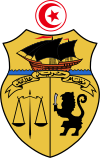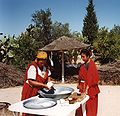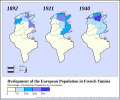Portal maintenance status: (September 2019)
|
|
User:محمد أمين الطرابلسي/sandbox3/box-header
Tunisia, officially the Republic of Tunisia, is the northernmost country in Africa. It is a part of the Maghreb region of North Africa, bordered by Algeria to the west and southwest, Libya to the southeast, and the Mediterranean Sea to the north and east. Tunisia also shares maritime borders with Italy through the islands of Sicily and Sardinia to the north and Malta to the east. It features the archaeological sites of Carthage dating back to the 9th century BC, as well as the Great Mosque of Kairouan. Known for its ancient architecture, souks, and blue coasts, it covers 163,610 km2 (63,170 sq mi), and has a population of 12.1 million. It contains the eastern end of the Atlas Mountains and the northern reaches of the Sahara desert; much of its remaining territory is arable land. Its 1,300 km (810 mi) of coastline includes the African conjunction of the western and eastern parts of the Mediterranean Basin. Tunisia is home to Africa's northernmost point, Cape Angela. Located on the northeastern coast, Tunis is the capital and largest city of the country, which is itself named after Tunis. The official language of Tunisia is Modern Standard Arabic. The vast majority of Tunisia's population is Arab and Muslim. Vernacular Tunisian Arabic is the most spoken, and French also serves as an administrative and educational language in some contexts, but it has no official status. Beginning in early antiquity, Tunisia was inhabited by the indigenous Berbers. The Phoenicians, a Semitic people, began to arrive in the 12th century BC, settling on the coast and establishing several settlements, of which Carthage emerged as the most powerful by the 7th century BC. The descendants of the Phoenician settlers came to be known as the Punic people. Ancient Carthage was a major mercantile empire and a military rival to the Roman Republic until 146 BC when it was defeated by the Romans who occupied Tunisia for most of the next 800 years. The Romans introduced Christianity and left architectural legacies like the Amphitheatre of El Jem. In the 7th century AD, Arab Muslims conquered all of Tunisia (finally succeeding in 697 after several attempts starting in 647) and settled with their tribes and families, bringing Islam and Arab culture to the local inhabitants. A later large-scale Arab migration of Banu Hilal and Banu Sulaym tribes in the 11th-12th centuries rapidly accelerated this process. By around the 15th century, the region of modern-day Tunisia had already been almost completely Arabized, establishing Arabs as the demographic majority of the population. Then, in 1546, the Ottoman Empire established control there, holding sway for over 300 years, until 1881, when the French conquered Tunisia. In 1956, Tunisia gained independence as the Tunisian Republic under the leadership of Habib Bourguiba with the help of activists such as Chedly Kallala, Farhat Hached, and Salah Ben Youssef. Today, Tunisia's culture and identity are rooted in this centuries-long intersection of different cultures and ethnicities. Tunisia is well integrated into the international community. It is a member of the United Nations, Organisation internationale de la Francophonie, the Arab League, the Organisation of Islamic Cooperation, the African Union, the Common Market for Eastern and Southern Africa, the Non-Aligned Movement, the International Criminal Court, the Group of 77, among others. It maintains close economic and political relations with some European countries, particularly with France, and Italy, due to their geographical proximity. Tunisia also has an association agreement with the European Union and has attained the status of a major non-NATO ally of the United States. (Full article...) User:محمد أمين الطرابلسي/sandbox3/box-header Djerba (/ˈdʒɜːrbə, ˈdʒɛərbə/; Arabic: جربة, romanized: Jirba, IPA: [ˈʒɪrbæ] ; Italian: Meninge, Girba), also transliterated as Jerba or Jarbah, is a Tunisian island and the largest island of North Africa at 514 square kilometers (198 sq mi), in the Gulf of Gabès, off the coast of Tunisia. Administratively, it is part of Medenine Governorate of this North African country. The island had a population of 139,544 at the 2004 census, which rose to 163,726 at the 2014 census. Citing its long and unique history, Tunisia has sought UNESCO World Heritage status protections for the island, and, in 2023, Djerba was officially designated a World Heritage Site. (Full article...)User:محمد أمين الطرابلسي/sandbox3/box-footer The page "User:محمد أمين الطرابلسي/sandbox3/box-header" does not exist. The page "User:محمد أمين الطرابلسي/sandbox3/Featured picture/8" does not exist. The page "User:محمد أمين الطرابلسي/sandbox3/box-header" does not exist. The page "User:محمد أمين الطرابلسي/sandbox3/Did you know/6" does not exist. User:محمد أمين الطرابلسي/sandbox3/box-header User:محمد أمين الطرابلسي/sandbox3/Categories User:محمد أمين الطرابلسي/sandbox3/box-footer User:محمد أمين الطرابلسي/sandbox3/box-header User:محمد أمين الطرابلسي/sandbox3/Related portals User:محمد أمين الطرابلسي/sandbox3/box-footer User:محمد أمين الطرابلسي/sandbox3/box-header User:محمد أمين الطرابلسي/sandbox3/WikiProjects User:محمد أمين الطرابلسي/sandbox3/box-footer User:محمد أمين الطرابلسي/sandbox3/box-header User:محمد أمين الطرابلسي/sandbox3/Topics User:محمد أمين الطرابلسي/sandbox3/box-footer User:محمد أمين الطرابلسي/sandbox3/box-header The following Wikimedia Foundation sister projects provide more on this subject:
User:محمد أمين الطرابلسي/sandbox3/box-footer User:محمد أمين الطرابلسي/sandbox3/box-header Discover Wikipedia using portals | |||||



















































































